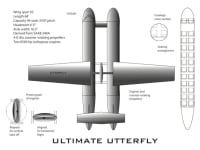The design I am submitting is for a 40-passenger commuter aircraft with vertical take off and landing capability. The aircraft is in stable equilibrium during all phases of its flight - during take off, cruising horizontally and landing. Stable equilibrium is achieved by having a single thrust axis. Engines and propellers are mounted between two fuselages; it is this unique geometry that facilitates stable flight characteristics. Disk loading is reduced by using four propellers which have the same disk load as one propeller of twice the diameter. There are two pairs of coaxial counter-rotating propellers. One pair is in front one in the rear. They are driven by two back-to-back turboprop engines. This arrangement cancels gyroscopic effects. Redundancy is provided by using two engines. In the event of failure of one engine the other engine drives the propellers. If both engines fail the propellers autorotate to slow the fall of the aircraft. Airbags deploy from below the fuselages soften the fall. The aircraft cruises at 350 knots and has a range of over 1000 miles. This speed and range is not possible with helicopters.
The aircraft is designed to take off and land from a parking lot, or even from the roof of buildings. Small towns that do not have airports can benefit from airline service. This aircraft will provide point-to-point taxi service. I believe this aircraft will be attractive for regional airlines that currently must operate from conventional airports. It will expand their service to remote towns. Mountainous areas that are currently inaccessible can be opened up to air traffic. This is especially useful in under-developed areas of the world. The aircraft is uniquely suitable for relief supplies after a natural disaster.
Operational costs are comparable with conventional turboprop powered commuter aircraft. Manufacturing costs are not very different either. The aircraft has military applications as an air-assault vehicle and as a gunship. The V-22 Osprey is the only operational VTOL/STOL aircraft. It is serving the Marines in Iraq and Afghanistan. However, because of its Tilt Rotor design it has stability issues. Although work-arounds have been implemented there has been a huge increase in weight, cost and complexity. Unlike the V-22 soldiers in my proposed aircraft can enter and exit the aircraft from the sides of the fuselages. My design also permits guns to be mounted and fired from the fuselages. Ordnance can be hung from hard points under wings. These are some of the advantages of my design over the V-22. I have tested a 5' wing-span radio controlled model. It has met 90% of the design goals. An operational model can be manufactured using conventional aircraft manufacturing techniques. I am seeking support from aircraft manufacturers.
Like this entry?
-
About the Entrant
- Name:Munawar Karim
- Type of entry:individual
- Patent status:none





